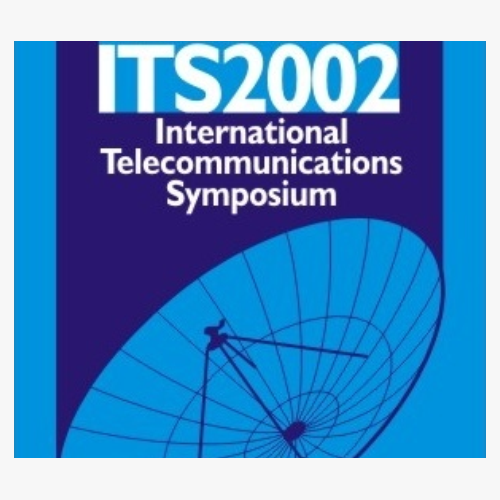
2002 International Telecommunications Symposium
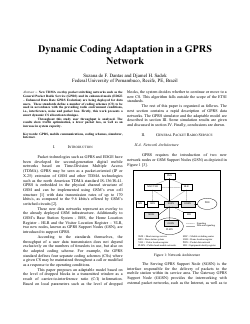
Dynamic Coding Adaptation in a GPRS Network
Suzana de F. Dantas, Djamel H. Sadok
DOI: 10.14209/its.2002.975
Keywords: GPRS mobile communications coding schemes simulator Internet
Abstract
"New TDMA overlay packet switching networks such as the General Packet Radio Service (GPRS) and its enhanced mode (EDGE \u2013 Enhanced Data Rate GPRS Evolution) are being deployed for data users. These standards define a number of coding schemes (CS) to be used in accordance with the prevailing radio environment conditions, i.e., interference, noise and packet loss. Firstly, this work presents a smart dynamic CS allocation technique. Throughout this study user throughput is analyzed. The results show traffic optimization, a lower packet loss, as well as an increase in system capacity."Download
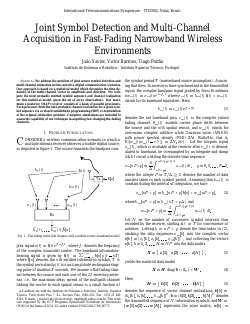
Joint Symbol Detection and Multi-Channel Acquisition in Fast-Fading Narrowband Wireless Environments
João Xavier, Victor Barroso, Tiago Patrão
DOI: 10.14209/its.2002.981
Keywords:
Abstract
"We address the problem of joint source symbol detection and multi-channel estimation in time-selective digital communication scenarios. Our approach is based on a statistical model which decouples the time dynamics of the multi-channel vector in amplitude and direction. We compute the most probable emitted symbol sequence and channel realization for this statistical model, given the set of array observations. Our maximum a posterior (MAP) receiver consists of a bank of parallel processors. Each processor finds the most probable channel realization for a given symbol sequence via a relaxed semidefinite programming (SDP) reformulation of the original estimation problem. Computer simulations are included to assess the capability of our technique in acquiring fast-changing flat-fading channels."Download

Blind Source Separation and Channel Identification: Exploiting 2nd Order Statistics in Bayesian Frameworks
João Xavier, Victor Barroso, Paulo Lopes
DOI: 10.14209/its.2002.987
Keywords:
Abstract
"We study how 2nd order statistics (SOS) can be exploited in two signal processing problems, blind separation of binary sources and trained-based multi-user channel identification, in a Bayesian context where a prior on the mixing channel matrix is available. It is well known that the SOS of the received data permit to resolve the unknown mixing matrix, up to an orthogonal factor. In a Bayesian framework, this residual orthogonal mixing matrix becomes a random object in its own right, with an associated distribution over the group of orthogonal matrices. This distribution is induced by the prior on the mixing matrix, and must be known for optimum statistical processing. We rely on a previous theoretical work to provide these answers, and discuss applications for this induced probability density function (pdf) over the orthogonal group, in the two aforementioned signal processing problems. Preliminary results, obtained through computer simulations, demonstrate the effectiveness of incorporating this induced distribution associated with the residual orthogonal matrix into the design of several estimators."Download
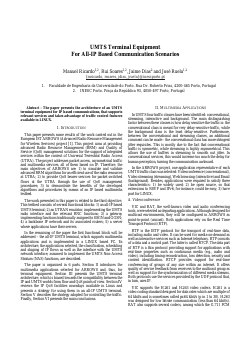
UMTS Terminal Equipment For All-IP Based Communication Scenarios
Manuel Ricardo, Rui Soares, Jaime Dias, José Ruela
DOI: 10.14209/its.2002.993
Keywords:
Abstract
"The paper presents the architecture of an UMTS terminal equipment for IP based communications, that supports relevant services and takes advantage of traffic control features available in LINUX."Download

Combined Dynamic Channel Assignment and Non-Linear Spatial Processing for High Throughput Packet Radio
R. R. de Araújo, F. R. P. Cavalcanti, J. C. M. Mota
DOI: 10.14209/its.2002.998
Keywords:
Abstract
"In this work we discuss the use of a dynamic packet to timeslot assignment (DPA) algorithm combined with a non-linear interference suppression method for a TDMA-based network equipped with an antenna array in the base station. Single and multicell cell scenarios are considered. The whole receiver strategy (combined DPA and non-linear spatial processing) is then evaluated for different degrees of spatial diversity. Results show that the combined strategy produces a considerable throughput improvement, especially for a high offered load condition."Download
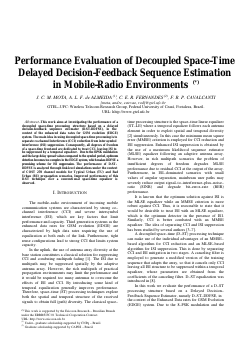
Performance Evaluation of Decoupled Space-Time Delayed Decision-Feedback Sequence Estimation in Mobile Radio Environments
J. C. M. Mota, A. L. F. de Almeida, C. E. R. Fernandes, F. R. P. Cavalcanti
DOI: 10.14209/its.2002.1004
Keywords:
Abstract
"This work aims at investigating the performance of a decoupled space–time processing structure based on a delayed decision-feedback sequence estimator (D-ST-DDFSE), in the context of the enhanced data rates for GSM evolution (EDGE) system. The main idea in using decoupled space-time processing is to separate co-channel interference (CCI) reduction from inter-symbol interference (ISI) suppression. Consequently, all degrees of freedom of a space–time front-end are dedicated to treat CCI, leaving ISI to be suppressed by a temporal equalizer. Due to the 8-PSK modulation and the large delay spread values compared to the symbol period, optimum detection becomes too complex in the EDGE system, which makes DDFSE a promising scheme for ISI suppression. The performance of D-ST-DDFSE is analyzed through link-level simulations under the context of COST 259 channel models for Typical Urban (TU) and Bad Urban (BU) propagation scenarios. Improved performance of this D-ST technique over a conventional space-time equalizer is observed."Download
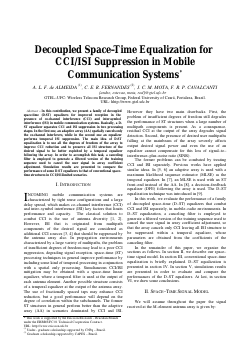
Decoupled Space-Time Equalization for CCI/ISI Suppression in Mobile Communication Systems
A. L. F. de Almeida, C. E. R. Fernandes, J. C. M. Mota, F. R. P. Cavalcanti
DOI: 10.14209/its.2002.1010
Keywords:
Abstract
"In this contribution, we present a family of decoupled spacetime (D-ST) equalizers for improved reception in the presence of co-channel interference (CCI) and inter-symbol interference (ISI) in mobile communication systems. Basically, a D-ST equalizer separates CCI and ISI suppression in two processing stages. In the first one, an adaptive array (AA) spatially cancels only the co-channel interferers, while in the second one an equalizer performs temporal ISI suppression. The main idea of D-ST equalization is to use all the degrees of freedom of the array to improve CCI reduction and to preserve all ISI structure of the desired signal to be better exploited by a temporal equalizer following the array. In order to accomplish this task, a canceling filter is employed to generate a filtered version of the training sequence used to cancel the user signal in array coefficient adjustment. Simulation results are presented to compare the performance of some D-ST equalizers to that of conventional space-time structures in CCI/ISI-limited scenarios."Download
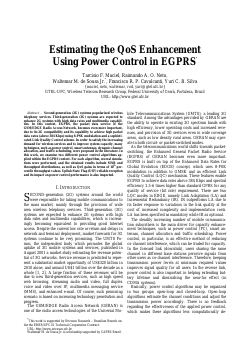
Estimating the QoS Enhancement using Power Control in EGPRS
Tarcisio F. Maciel, Raimundo A. O. Neto, Waltemar M. de Sousa Jr., Francisco R. P. Cavalcanti, Yuri C. B. Silva
DOI: 10.14209/its.2002.1016
Keywords:
Abstract
"Second-generation (2G) systems popularized wireless telephony services. Third-generation (3G) systems are expected to enhance 2G systems with high data rates and multimedia capabilities. In this context, EGPRS, the packet data service of the GSM/EDGE Radio Access Network, becomes even more important, due to its 2G compatibility and its capability to achieve high packet data rates (above 384 Kbps) using 8-PSK modulation and a sophisticated Link Quality Control scheme. In order to satisfy the increasing demand for wireless services and to improve system capacity, many techniques, such as power control, smart antennas, dynamic channel allocation, and traffic scheduling, were proposed in the literature. In this work, we examine two different power control algorithms applied within the EGPRS context. For each algorithm, several simulations were performed, and the obtained results include SINR and throughput distributions, as well as QoS gains in terms of 10th percentile throughput values. Uplink State Flag (USF) reliable reception and its impact on power control performance is also inspected."Download

New Algorithms for Adaptive Antennas in DS-CDMA Communication Systems
Antônio R. R. de Matos, Adaildo G. D’Assunção, Laércio M. de Mendonça
DOI: 10.14209/its.2002.1022
Keywords:
Abstract
"In this paper two new adaptive algorithms are presented: Multipath Least-Squares Despread Respread Multitarget Array (MLS-DRMTA) and Multipath Recursive Least-Squares (MRLS) algorithms, in order to improve the performance of adaptive antenna arrays in the presence of multipaths. It is shown from simulation that the diagrams radiation formed with the new algorithms developed points beams toward the directions of the entire desired signal arriving multipaths, while that one formed with LS-DRMTA and RLS points only a main beam in the direction of the multipath which is synchronized with the receiver. Thus the new algorithms are indicated to perform coherent combination of multipaths. In the simulations carried through in this work, the generated results are gotten through the use of adaptive antenna arrays situated in Stations of Radio Base (ERB) and destined to the reception of the signal of the users in DS-CDMA communication systems."Download

Performance Analysis of GSM-GPRS Network
G. H. S. Carvalho, M. B. L. Santos, J. C. W. A. Costa
DOI: 10.14209/its.2002.1026
Keywords: Network performance GSM network GPRS network M/M/c/c queue
Abstract
"To provide Internet Services with much better utilization of frequency spectrum the General Packet Radio Service (GPRS) is integrated in a GSM network. However, some questions to arise about the network performance when these networks are integrated, once that they share the same radio resource of the air interface. Hence, on this article an analytic model is developed using the M/M/c/c queue, which is used to analyze the integrated GSM-GPRS network. That model is based on the voice services pre-emption over the Internet services to provide measures that inform the availability of radio resource, and this way, the throughput of the GPRS to any offered voice traffic profile on the GSM network."Download